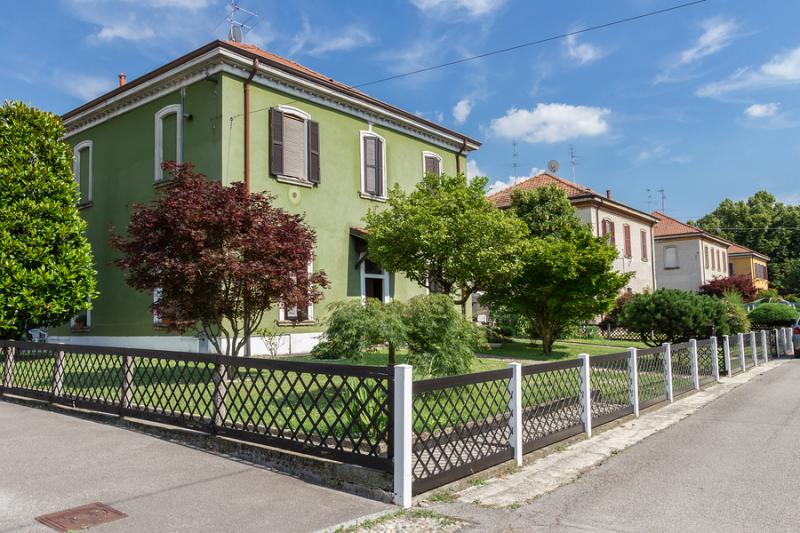Unesco Sites of Italy: Crespi d’Adda
ITA:

Use player to listen to Italian version
Crespi d’Adda is probably one of the least known Unesco sites of Italy. Located in Capriate San Gervasio in the northern region of Lombardy, it is, according to Unesco, “an outstanding example of the 19th- and early 20th-century 'company towns' built in Europe and North America by enlightened industrialists to meet the workers' needs.”
The village was founded by Cristoforo Benigno Crespi to house the workers in his textile factory and its final form was developed by Cristoforo’s son, Silvio Benigno Crespi, who had studied the functioning of German and English cotton mills, explains Unesco. Silvio Crespi designed the town to “provide comfortable housing and services in order to maintain a stable workforce and prevent industrial strife.”
Completed in the late 1920s, Crespi d’Adda offered employees a high standard of living thanks to multi-family homes, each with a garden, and highly advanced community services for the time. The village was arranged according to a geometrically regular shape, intersected by a main road. The factories and offices were located on one side of the road, corresponding to the left bank of the Adda river, while the village itself was on the opposite side of the road and followed a rectangular grid of roads along three lines. The houses differed from each other in style, depending on the role that its occupants played within the factory, and the variety contributed to offering a pleasant urban landscapes.
Workers benefited from other services in addition to housing, including public toilets and laundries, a clinic, a consumer cooperative, a school, a small theater, a sports center, a home for the local priest and a home for the doctor, a hydroelectric station that provided electricity and other common services free of charge.
Crespi d’Adda was owned by a single company until the 1970s, when many buildings, especially houses, began being sold to private individuals. As a consequence of depopulation, the town’s industrial activity declined as well.
Crespi d’Adda è probabilmente uno dei siti Unesco meno conosciuti d'Italia. Situato a Capriate San Gervasio, nella regione settentrionale della Lombardia, è, secondo l'Unesco, “un eccezionale esempio di ‘città aziendale’ del XIX° e inizio XX° secolo, cioè quelle città costruite in Europa e Nord America da industriali illuminati pensate per venire incontro alle esigenze dei lavoratori.”
Il villaggio fu fondato da Cristoforo Benigno Crespi per ospitare gli operai della sua fabbrica tessile e la sua struttura finale fu sviluppata dal figlio di Cristoforo, Silvio Benigno Crespi, che aveva studiato il funzionamento dei cotonifici tedeschi e inglesi, spiega l'Unesco. Silvio Crespi progettò la città per “fornire alloggi e servizi confortevoli al fine di mantenere una forza lavoro stabile e prevenire conflitti.”
Completata alla fine degli anni ‘20, Crespi d'Adda offriva ai dipendenti un elevato standard di vita grazie a case plurifamiliari, ognuna con giardino, e servizi comunitari altamente avanzati per l'epoca. Il villaggio era organizzato secondo una forma geometricamente regolare, intersecata da una strada principale. Le fabbriche e gli uffici erano situati su un lato della strada, corrispondente alla riva sinistra del fiume Adda, mentre il villaggio stesso era sul lato opposto della strada e seguiva una griglia rettangolare di strade lungo tre linee. Le case si differenziavano l'una dall'altra nello stile, a seconda del ruolo svolto dai suoi occupanti all'interno della fabbrica, e questa varietà contribuiva a creare un paesaggio urbano gradevole.
I lavoratori beneficiavano di altri servizi oltre all'abitazione, inclusi servizi igienici e lavanderie pubblici, una clinica, una cooperativa per i consumatori, una scuola, un piccolo teatro, un centro sportivo, una casa per il sacerdote e una casa per il medico, una centrale idroelettrica che forniva elettricità gratuitamente e altri servizi comuni.
Crespi d'Adda rimase proprietà di una sola azienda fino agli anni '70, quando molti edifici, in particolare le case, iniziarono a essere venduti a privati. Come conseguenza dello spopolamento, anche l'attività industriale della città è diminuita.











